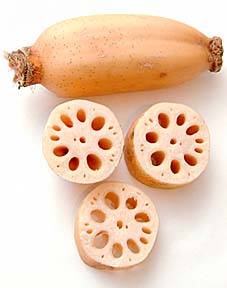

Key Ingredient

The lotus plant is beloved in Asian culture not only as a sacred symbol of Buddhist culture, but because of its culinary gems. Its leaves, seeds and especially its root are enjoyed in a variety of sweet and savory dishes. LOTUS ROOT
The leaves are used for flavoring as well as to wrap steamed dishes, the seeds are most often dried or candied and used in pastry fillings, the root is reserved for hearty stewed dishes.
The basics: Lotus root, commonly known as renkon or hasu in Japanese, is the underwater stem or rhizome of the lotus plant -- a member of the water lily family. It is a rather unusual-looking vegetable that resembles large sausage links that grow up to 4 feet long and on average 2 to 3 inches in diameter. A unique set of air holes creates a snowflake-like pattern in the root, which is revealed when the root is sliced. The texture is crisp and crunchy with a flavor that hints of fresh coconut and water chestnut.
Selecting: Look for nice tan roots with unblemished skin. Although some dirt may cover the root, it should smell fresh and clean. Choose roots that are solid and feel heavy for their size.
Storing: Store as you would potatoes in the refrigerator up to one week.
Use: The root needs to be cleaned of all dirt and mud. The flesh will discolor as soon as it is sliced, so make sure to have a bowl of acidulated water (water mixed with lemon juice or vinegar) ready. Peel off the outer skin, then slice the root horizontally. A popular use for lotus root locally is in nishime, the Japanese stewed vegetable dish. But a quick stir-fry, seasoned with sake, soy sauce, sugar and a dash of red-pepper flakes, makes a tasty side dish as well.
The root can also be enjoyed raw and thinly sliced in salads or simmered in soups.
Candied lotus root and a sweet pastry with a filling made from the root are traditional Chinese desserts.
Where to buy: Fresh lotus root is generally available year-round in supermarkets and in Chinatown. Roots run $1.99 to $3.99 a pound. You can also find them canned or frozen.
Food Stuffs: Morsels
Contact Eleanor Nakama-Mitsunaga
online at features@starbulletin.com
Asterisk (*) after nutritional analyses
indicates calculations by
Joannie Dobbs of Exploring New Concepts,
a nutritional consulting firm.